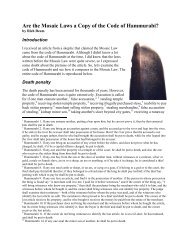DNA Evidence and Molecular Genetics Disprove the Book of Mormon
DNA Evidence and Molecular Genetics Disprove the Book of Mormon
DNA Evidence and Molecular Genetics Disprove the Book of Mormon
You also want an ePaper? Increase the reach of your titles
YUMPU automatically turns print PDFs into web optimized ePapers that Google loves.
<strong>DNA</strong> <strong>Evidence</strong> <strong>and</strong> <strong>Molecular</strong> <strong>Genetics</strong> <strong>Disprove</strong> <strong>the</strong> <strong>Book</strong> <strong>of</strong> <strong>Mormon</strong> page 6 <strong>of</strong> 14<br />
By Rich Deem<br />
haplogroups A2, B2, C, D1, <strong>and</strong> X2a, <strong>and</strong> found that all haplogroups originated between 20,000<br />
<strong>and</strong> 22,000 years ago, suggesting a single migratory origin for all Native Americans. 23 This data<br />
directly contradicts <strong>the</strong> LDS claim that Middle Eastern haplogroups contributed to Native<br />
American genetics some 2,600 years ago.<br />
Polymorphic Alu insertions<br />
The Alu family <strong>of</strong> retroposons is present at an extremely large copy number within <strong>the</strong><br />
chromosomes <strong>of</strong> <strong>the</strong> human genome (500,000 copies/genome equivalent), representing<br />
approximately 10% <strong>of</strong> its mass. The majority <strong>of</strong> <strong>the</strong>se elements are thought to be<br />
transcriptionally inactive pseudogenes. The distribution <strong>of</strong> <strong>the</strong> polymorphic Alu insertions is<br />
variable within population groups from different geographic origins, <strong>and</strong> is not r<strong>and</strong>om along<br />
individual human chromosomes.<br />
A study examined 5 polymorphic Alu insertions in 895 unrelated individuals from 24 Native<br />
American populations compared to a worldwide population survey. 24 The results showed a close<br />
similarity between <strong>the</strong> Chinese <strong>and</strong> Native Americans, demonstrating a recent gene flow from<br />
Asia.<br />
A more recent study examined <strong>the</strong> Alu insertion located in <strong>the</strong> 3' untranslated region <strong>of</strong> <strong>the</strong><br />
LDLR gene, studying Mongolian, Siberian, <strong>and</strong> Native American populations. 25 Seven<br />
haplotypes were identified, with <strong>the</strong> greatest diversity between Siberian <strong>and</strong> Native American<br />
populations compared to Mongolians. The conclusions supported earlier mt<strong>DNA</strong> <strong>and</strong> Ychromosome<br />
data, suggesting a single origin for <strong>the</strong> first colonizers <strong>of</strong> <strong>the</strong> American continent.<br />
Gut microbial flora<br />
Helicobacter pylori, a chronic gastric pathogen <strong>of</strong> human beings, can be found in virtually every<br />
human population group. Variations <strong>of</strong> <strong>the</strong> bacteria can be divided into seven populations <strong>and</strong><br />
subpopulations with distinct geographical distributions. Analysis <strong>of</strong> <strong>the</strong>se bacteria within native<br />
populations worldwide reveals that <strong>the</strong> East Asian strain <strong>of</strong> Helicobacter pylori can be isolated<br />
from Native Americans, indicating that East Asians are <strong>the</strong> likely ancestor <strong>of</strong> Native<br />
Americans. 26<br />
23 Fagundes, N.J.R., et al. 2008. Mitochondrial Population Genomics Supports a Single Pre-Clovis Origin with a<br />
Coastal Route for <strong>the</strong> Peopling <strong>of</strong> <strong>the</strong> Americas. American Journal <strong>of</strong> Human <strong>Genetics</strong> 82: 583-592.<br />
24 Novick GE, Novick CC, Yunis J, Yunis E, Antunez de Mayolo P, Scheer WD, Deininger PL, Stoneking M, York<br />
DS, Batzer MA, Herrera RJ. 1998. Polymorphic Alu insertions <strong>and</strong> <strong>the</strong> Asian origin <strong>of</strong> Native American<br />
populations. Hum. Biol. 70:23-39.<br />
25 Heller AH, Salzano FM, Barrantes R, Krylov M, Benevolenskaya L, Arnett FC, Munkhbat B, Munkhtuvshin N,<br />
Tsuji K, Hutz MH, Carnese FR, Goicoechea AS, Freitas LB, Bonatto SL. 2004. Intra- <strong>and</strong> intercontinental molecular<br />
variability <strong>of</strong> an Alu insertion in <strong>the</strong> 3' untranslated region <strong>of</strong> <strong>the</strong> LDLR gene. Hum. Biol. 76:591-604.<br />
26 Falush D, Wirth T, Linz B, Pritchard JK, Stephens M, Kidd M, Blaser MJ, Graham DY, Vacher S, Perez-Perez<br />
GI, Yamaoka Y, Megraud F, Otto K, Reichard U, Katzowitsch E, Wang X, Achtman M, Suerbaum S. 2003. Traces<br />
<strong>of</strong> human migrations in Helicobacter pylori populations. Science 299: 1528-1529.<br />
<strong>Evidence</strong> for God from Science http://www.GodAndScience.org






